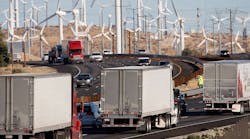Last week, a regulation that was based on a law passed in 2008 has now gone fully into effect. Lots of new, light-duty vehicles need to have backup cameras and a display in the dash. EPA wants to lessen the impact of regulations put into place in late 2016 are being contested in the courts thanks to California and other states.
Tariffs are threatening to raise costs significantly. ELD rules are being adjusted through both laws and revised regulations for exceptions. Even when we have a leader in the White House that proclaims to be business friendly, and a Congress controlled by the same party as the White House, regulations and laws continue to be a big issue.
For instance, we have legislation going in Congress related to testing and production of autonomous vehicles, some of which is intended to take precedence over independent state regulations. In Europe, they are expecting the latest in CO2 regulations and ACEA recently indicate a need for continent wide regulations that take into account the different vehicle types, rather than state and municipality regulations. Rules for cities requiring emissions-free vehicles in certain areas are pushing electric vehicles, even though they do not provide a financial return. This week, a non-governmental organization (NGO) called the Road to Zero Coalition issued a report through the RAND corporation.
I’m expecting this to drive cleaner, safer vehicles—autonomous, connected, and electric—an ACE in the whole world. I expect to see much more on trailers in particular. I’ve seen GM and Ford offering cameras on the vehicle, and ways to see behind, around, and through a towed trailer. In the Class 8 market, Great Dane, Phillips Industries, Truck-Lite, Grote, Peterson, and, maybe some I’ve missed, have talked about additional automation on the trailer to improve safety, fuel economy, and other operational expenses.
A decade ago, trailer tracking was not of much interest. Today, it is much more so. If we did not have an average of 1 tractor to 2.5-3 trailers, we might see trailers in the future that have their own powertrain and autonomously move about. Instead of a yard hauler that is autonomous, it could be more like something that slips under the trailer to move it around in a yard. Unless regulations allow the more efficient movement of doubles and triples, it’s possible government could push in the direction of driverless trailers.
The next decade is going to see some serious arguments regarding states rights for controlling vehicles. I recently began dealing with states requirements on light-duty trailers with supplemental brakes. It’s a similar hodge-podge to the weight limits and other regulations for Class 8. It won’t be easy to find a solution to federal rights versus states rights in regards to safety of the environment (remember the armed conflicts over water rights in the past). I am certain that the health of our economy will benefit from consistent rules across the country.
Maybe, instead of being forced to comply, we need to force the government. Let your money and your vote count for what you believe is right.



